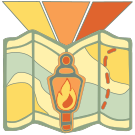Trail: Learn About Attention
 | |
| Trail: Learn About Attention | |
|---|---|
| Landmarks | Use Sounds to be Present Acknowledge Negative Emotions Without Judgment Notice Multiple Sensations |
A Trail in the context of Everyday Enlightenment is a curated journey of self-discovery and personal growth. It is a structured way of traveling through concepts and practices and is designed to guide you towards mindfulness and deeper understanding. Using a Trail helps you systematically navigate and explore the vast landscape of meditative insights, providing you with achievable goals and practical techniques to integrate these insights into your everyday life.
What is Attention?
Attention, one of the three Beacons of Everyday Enlightenment, illuminates the path to presence and mindfulness in our daily lives. The core of Attention is fostering a profound connection with the immediate unfolding of life, moment to moment. By developing skills centered on Attention, we endeavor to cultivate a mindful awareness that significantly reduces suffering, enhances mental clarity, and deepens our appreciation of life's inherent beauty.
One key aspect of Attention lies in learning to release the grip of distracting thoughts and emotions. These might lead us away from what we truly desire to focus on or, worse still, inflict undue pain and suffering. Engaging with the world through the lens of Attention allows us to remain centered, irrespective of the turbulence that might be unfolding around or within us.
Moreover, Attention invites us to anchor ourselves in the richness of the present moment, the home of authentic satisfaction. It is here, in the 'now', that we fully experience the breadth of our existence, basking in the pleasures that life offers, while also acknowledging and working through challenges with a clear and focused mind.
Attention brings into sharp focus the reality of our experience, stripping away the superfluous and illuminating the truth of our present moment. Through this beacon, we learn to savor the positive, navigate the negative, and above all, remain engaged and active participants in the tapestry of our lives. Attention, in essence, paves the way to a more mindful, aware, and fulfilling existence.
Where will this Trail take you?
This trail is designed to take you to a place where you have a basic understanding of the Beacon of Attention, including the Lenses of Mindfulness, Non-Judgement and Presence, as well as the Credo of Experience the Now. Once you've completed this trail, it is recommended you read through the content on the Attention page.
Landmark: Use Sounds to be Present
 | |
| Landmark: Use Sounds to be Present | |
|---|---|
| Beacons | Attention |
| Realms | Enrollment |
| Lenses | Presence |
| Guides | Sounds |
| Trails | Learn About Attention |
The Landmark of Use Sounds to be Present asks about your ability to notice how listening to sounds can quickly bring your wandering mind back to your present experience. This Landmark is within the Realm of Enrollment, and is part of the Beacon of Attention, more specifically the Lens of Presence.
Review these Lookouts to see what you may have learned at this Landmark.
Landmark Lookouts:
- Notice Your Wandering Mind: Are you able to notice times when your mind wanders?
- Experiment with Sounds and Presence: Can you identify the experience of sounds pulling you back into the present and keeping you in the present?
- Sounds as Anchors: Do you notice and sense that as long as you listen to sounds in the present moment your mind is less likely to stray?
Quite often you'll find a great variety of sounds outside, which is the perfect time to use these concepts.
- You're outside, maybe walking your dog, or sitting in your backyard. It's a regular part of your day.
- As you're enjoying your surroundings, let your mind wander freely. Let it daydream.
- Amidst the daydreaming, bring your attention to the sounds around you.
- The distant sound of traffic, the rustling leaves, the birds singing - tune into one of these sounds, whichever one you like.
- Each time a particular sound catches your attention, let it pull you out of your daydream, anchoring you back to reality.
- Acknowledge the thought or daydream that was interrupted by the sound, let it go, then return to listening.
- Continue this practice of allowing sounds to interrupt your daydreams, noting the shift in your attention.
- Reflect on how the sounds around you can serve as tools to bring you back to the present moment.
- Take a few more moments and listen intently to one of the sounds. Notice that as long as you listen, your mind is less likely to drift.
- Incorporate this practice into your day to cultivate the habit of using sounds as anchors to the present moment.
Once you've experimented with this example, double check your progress with the Landmark Lookouts above.
Landmark: Acknowledge Negative Emotions Without Judgment
 | |
| Landmark: Acknowledge Negative Emotions Without Judgment | |
|---|---|
| Beacons | Attention |
| Realms | Enrollment |
| Lenses | Non-Judgment |
| Guides | Stressful Moments |
| Trails | Learn About Attention |
The Landmark of Acknowledge Negative Emotions Without Judgment is where you'll discover how often we pass judgement on what goes on around us. The example chosen is driving or commuting, but you can choose anything about your typical day that may be frustrating or boring, or mildly unpleasant in some way. Learning about judgement is the first step in learning about Non-Judgement. This Landmark is within the Realm of Enrollment, and is part of the Beacon of Attention, more specifically the Lens of Non-Judgment.
Review these Lookouts to see what you may have learned at this Landmark.
Landmark Lookouts:
- Observe Emotions: Are you aware of your emotions as entities separate from your core being, observing them come and go?
- Acknowledge Negative Emotions: Can you identify negative emotions as they surface and acknowledge they exist without passing judgement?
Start your daily commute just like any other day, and incorporate these types of practices.
- As you sit in your car, or on the bus or train, notice how you're feeling.
- If it's frustration at the traffic or annoyance at the crowds, let it bubble up.
- Instead of fighting it, recognize it. Say to yourself, "I'm feeling frustrated," or "I'm feeling annoyed."
- Notice how this emotion feels in your body. Is your grip on the steering wheel tighter? Are your shoulders tense?
- As your journey continues, wait for another emotion or feeling to arise, and this time just acknowledge "I notice this feeling."
- Notice that you may still have reactions in your body, like tension, your heart or breath may feel accelerated, you may feel heat in your head.
- Finally, recognize that mental emotions and physical sensations are two different things.
Once you've experimented with this example, double check your progress with the Landmark Lookouts above.
Landmark: Notice Multiple Sensations
 | |
| Landmark: Notice Multiple Sensations | |
|---|---|
| Beacons | Attention |
| Realms | Enrollment |
| Lenses | Mindfulness |
| Guides | Eating |
| Trails | Learn About Attention |
The Landmark of Notice Multiple Sensations starts out with simple Mindful practices of using smell, taste, and touch to Experience the Now. This Landmark is within the Realm of Enrollment, and is part of the Beacon of Attention, more specifically the Lens of Mindfulness.
Review these Lookouts to see what you may have learned at this Landmark.
Landmark Lookouts:
- Paying Attention to a Sensation: Can you practice paying attention to one sensation at a time - such as smelling your meal?
- Paying Attention to Multiple Sensations: Can you hold your attention on two or more sensations at a time - such as smelling your meal and feeling your smooth utensils? Can you feel the difference as you move back and forth between single sensations and multiple sensations?
- Sensations in The Now: Do you feel how the "weight" of sensations in the present is different than other thoughts which are not part of "Experiencing the Now"?
Doing this oatmeal example (or something similar), you'll be introduced to the first basic concepts of practicing Mindfulness, as part of simply eating something. There is a lot more to it, but just the simple act of paying attention to sensations is enough to help you "Experience the Now".
- When it's time for your next meal, sit down at your table with your plate of food.
- Before you begin eating, take a moment to appreciate the sight and smell of your food.
- As you pick up your fork or spoon, bring all your attention to the act of eating.
- Pay attention to every sensation of each bite - the flavors, the texture, the temperature, the muscles used in chewing and swallowing.
- With your attention fully on the experience of eating, notice that all of these sensations make up "The Now" - this is what is happening!
- When your mind wanders, notice where it goes, then gently guide it back to your eating.
- Even if your mind wanders a hundred times, bring it back a hundred times.
- Clean up after your meal, maintaining your focus on the present moment.
Once you've experimented with this example, double check your progress with the Landmark Lookouts above.
Destination
Congratulations, if you've completed these Landmarks, you are one Trail further along in your practice. Now that you have a basic idea of the concept, it's recommended you read through the article about the Beacon of Attention and see if it starts to click with you. Then, look for other Trails and Landmarks that are in the Enrollment Realm that can assist you further.
Resources
- How to Practice Acceptance Without Being Complacent - "Mindful "acceptance" means that we fully acknowledge the current moment (external situation as well as feelings, thoughts, and perceptions) so that we can respond appropriately in the next moment."
- Practicing Non-Judgment - "What would it be like to simply experience something, without judgment?"
- How Present-Moment Awareness Can Make Life More Meaningful - "Presence involves a simple yet incredible shift—from the ordinary state of mind wandering to bringing our attention to the experience of what is happening right now. You can make this shift anytime, anywhere."
- Non-Judgment for Beginners! - "Non-judgment is a HOW skill where we practice being present in the current moment and stating a fact without adding our personal opinion to it."
- Acceptance is not Giving Up, it is Waking Up - "Acceptance allows us to see things as they really are, rather than spending so much time being pulled off-course by our attachment to our desire that things were different."
- Getting Started with Mindfulness - "Mindfulness is the basic human ability to be fully present, aware of where we are and what we’re doing, and not overly reactive or overwhelmed by what’s going on around us."
